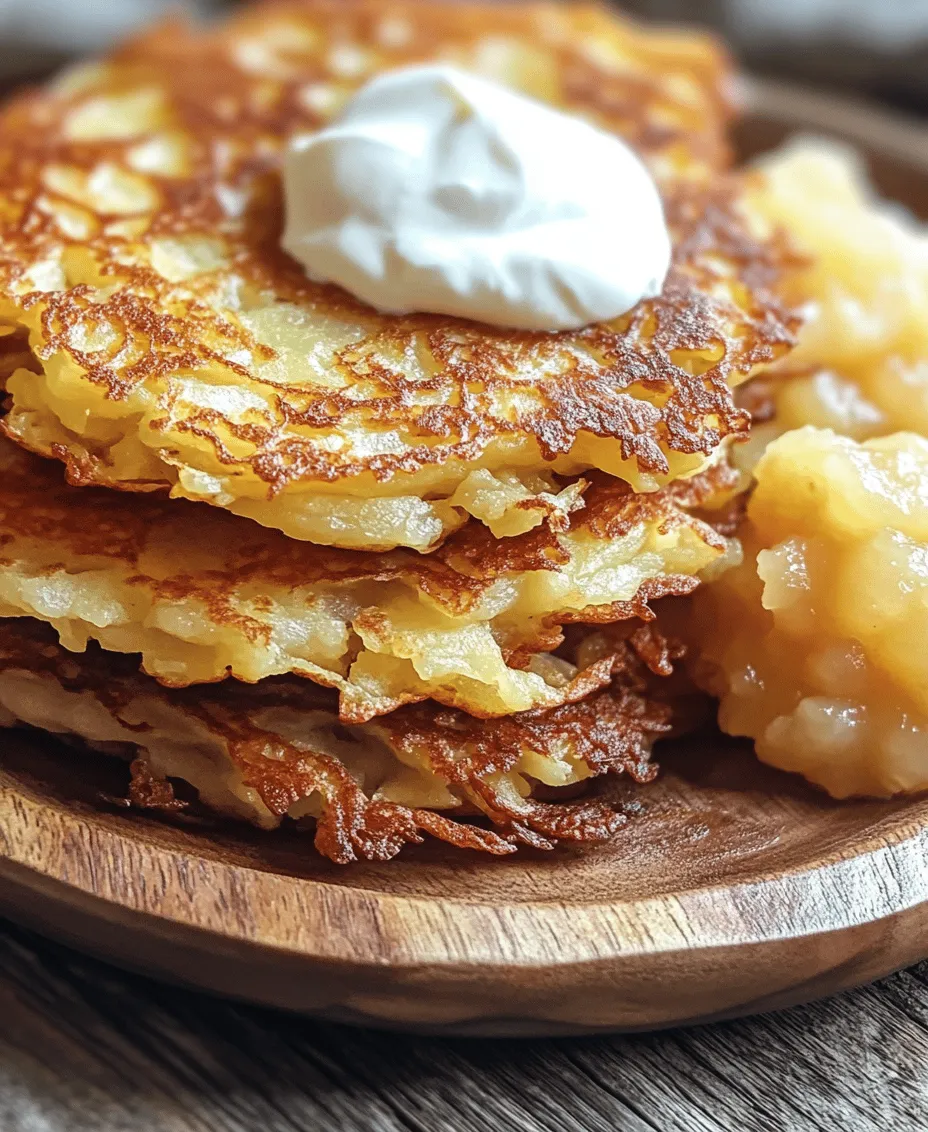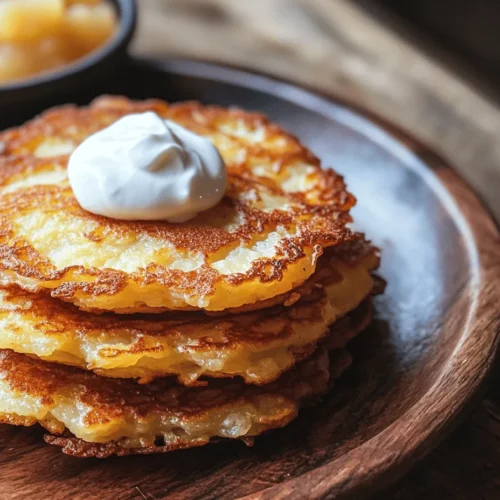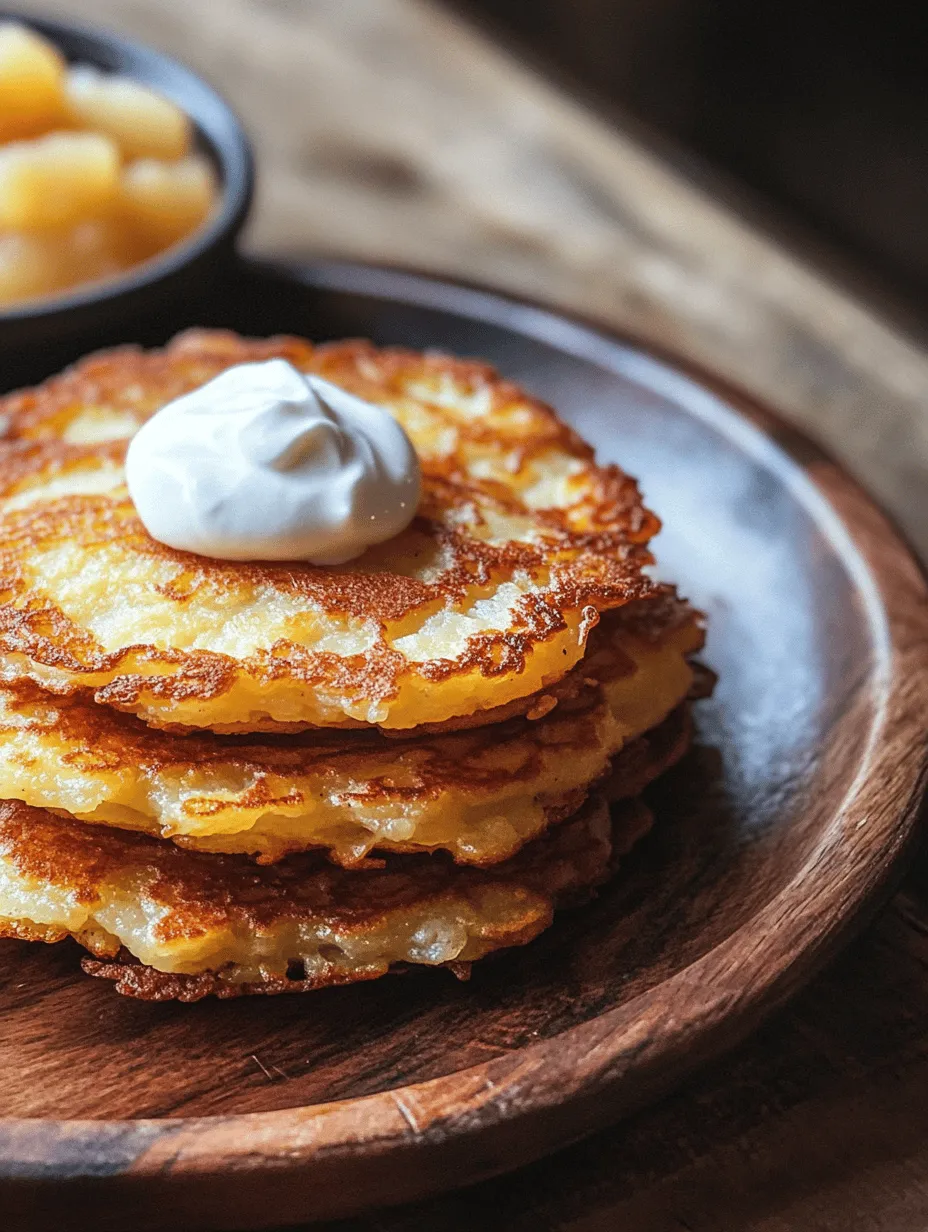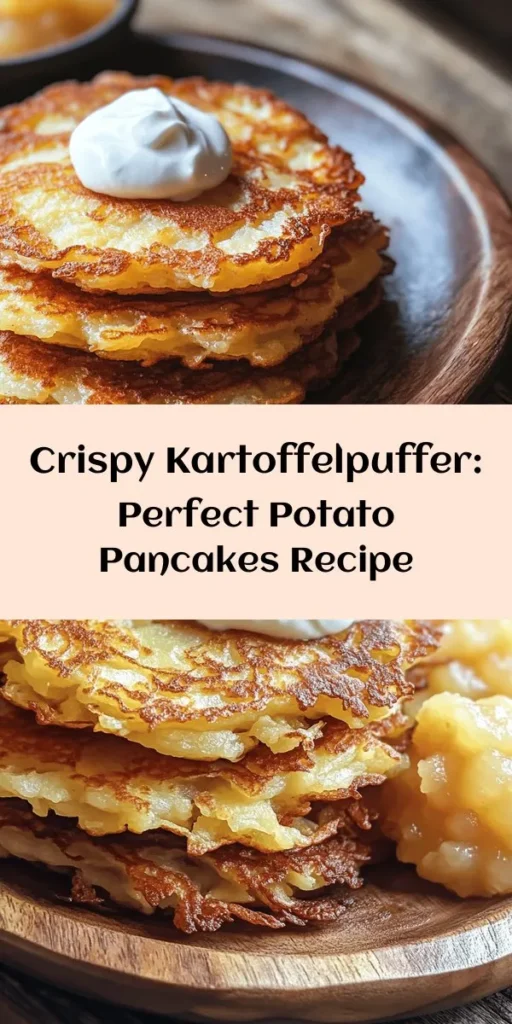Crispy Kartoffelpuffer, also known as potato pancakes, epitomize the essence of comfort food with their golden-brown exterior and tender, flavorful center. Originating from Germany, these delightful fritters are not only simple to prepare but also provide a satisfying crunch that elevates any meal. Made predominantly from grated potatoes, they can easily be adapted to suit your taste preferences, making Kartoffelpuffer a versatile dish that can be enjoyed at breakfast, lunch, or dinner. In this article, we will delve deep into the rich history and cultural significance of Kartoffelpuffer, explore their nutritional benefits, break down the key ingredients necessary for an exceptional dish, and guide you through the step-by-step process of making these irresistible potato pancakes.
Understanding Kartoffelpuffer
The History of Kartoffelpuffer
The origins of Kartoffelpuffer can be traced back to the heart of German cuisine, where potatoes have long been celebrated as a staple food. Introduced to Europe in the late 16th century, potatoes quickly became a dietary mainstay, particularly in Germany, where they were incorporated into various traditional dishes. Kartoffelpuffer emerged as one of the many ways to prepare this versatile tuber, allowing cooks to make use of leftover potatoes and create a filling, satisfying meal.
As one travels through Germany, one can find regional variations of Kartoffelpuffer that reflect local tastes and ingredients. For instance, in the region of Hesse, a version called “Reibekuchen” is popular, featuring a similar preparation but often served with apple sauce. Meanwhile, in the Rhineland, they may be accompanied by savory toppings such as smoked salmon or crème fraîche. This versatility speaks to the cultural significance of Kartoffelpuffer as a dish that transcends boundaries, uniting families and friends over shared flavors and experiences.
Culturally, Kartoffelpuffer holds a special place in German festivities and celebrations, particularly during the winter months when street vendors serve them at Christmas markets. The aroma of freshly fried potato pancakes wafting through the air evokes nostalgia and warmth, making them a beloved treat for many. Whether served as a side dish, a snack, or a main course, Kartoffelpuffer is a dish that brings people together and celebrates the simple pleasures of homemade cooking.
Nutritional Benefits of Potatoes
Potatoes, specifically russet potatoes, are the star ingredient in Kartoffelpuffer, and they offer numerous health benefits. Rich in vitamins and minerals, russet potatoes are an excellent source of vitamin C, potassium, and vitamin B6. They also contain dietary fiber, which plays a crucial role in digestive health.
When compared to other common vegetables, potatoes stand out for their carbohydrate content, providing a quick source of energy. This makes them particularly beneficial for active individuals. However, it’s essential to balance potato consumption with other vegetables to ensure a varied and nutritious diet. Incorporating potatoes into your meals can contribute to a well-rounded diet that supports overall health and wellbeing.
Notably, the way potatoes are prepared can affect their nutritional profile. When transformed into Kartoffelpuffer, the addition of eggs, onions, and minimal flour helps to enhance their nutritional value while keeping the dish relatively light. By choosing healthier cooking methods, such as pan-frying with a small amount of oil, you can enjoy the crispy texture without excessive calories.
Ingredients Breakdown
Key Ingredients for Perfect Kartoffelpuffer
The foundation of great Kartoffelpuffer lies in the quality of its ingredients. Here’s a breakdown of the essential components that make these potato pancakes irresistible:
– Russet Potatoes: Russet potatoes are ideal for Kartoffelpuffer due to their high starch content, which results in a fluffy interior and crispy exterior when cooked. Their natural moisture content allows them to hold together well during frying, ensuring that your pancakes maintain their shape and texture.
– Onion: The addition of onion is crucial for flavor, as it adds a subtle sweetness and depth to the Kartoffelpuffer. Grated or finely chopped, onions meld beautifully with the potatoes, enhancing the overall taste of the dish.
– Eggs: Eggs serve as a binding agent, helping to hold the grated potato and onion mixture together. They also contribute richness and moisture, ensuring that the pancakes remain tender and flavorful.
– Flour and Baking Powder: A small amount of flour is necessary to help absorb excess moisture from the potatoes, while baking powder aids in achieving a light and airy texture. These ingredients ensure that your Kartoffelpuffer are crispy on the outside while remaining soft on the inside.
– Seasoning: Simple seasonings such as salt, pepper, and garlic powder can elevate the flavor of Kartoffelpuffer significantly. Seasoning the mixture properly ensures that each bite is bursting with flavor, enhancing the overall dining experience.
Optional Ingredients for Customization
While the traditional recipe for Kartoffelpuffer is delicious on its own, there are plenty of ways to customize and elevate your pancakes. Here are some optional ingredients to consider:
– Variations in Seasoning and Accompaniments: Experimenting with different herbs and spices can introduce new flavors to your Kartoffelpuffer. Consider adding fresh herbs like dill or chives for a refreshing twist, or try seasoning with paprika or cumin for a touch of warmth. Additionally, pairing Kartoffelpuffer with sauces like sour cream or apple sauce can enhance the overall experience.
– Alternative Flour Options: For those with dietary restrictions, alternative flour options such as gluten-free flour or almond flour can be used in place of all-purpose flour. This allows everyone to enjoy the crispy goodness of Kartoffelpuffer without compromising on taste.
– Incorporating Herbs or Spices: To add depth to your Kartoffelpuffer, consider mixing in finely chopped herbs or spices directly into the batter. Ingredients like thyme, rosemary, or even a pinch of cayenne pepper can introduce exciting flavor profiles that complement the potatoes well.
Step-by-Step Guide to Making Crispy Kartoffelpuffer
Now that we’ve explored the history, nutritional benefits, and key ingredients of Kartoffelpuffer, it’s time to get into the kitchen and start cooking! Here’s a detailed, step-by-step guide to making perfectly crispy Kartoffelpuffer:
1. Preparation of Ingredients: Begin by gathering all your ingredients and equipment. You will need a box grater or food processor for grating the potatoes, a mixing bowl, a frying pan, and a spatula.
2. Grating the Potatoes: Peel the russet potatoes and grate them using a box grater or a food processor. Aim for a coarser grate to ensure a satisfying texture in your pancakes. Place the grated potatoes into a clean kitchen towel or cheesecloth and squeeze out as much moisture as possible. This step is crucial in achieving crispy Kartoffelpuffer.
3. Chopping the Onion: Finely chop the onion and add it to the bowl with the grated potatoes. The onion will infuse flavor into the batter and contribute to the overall texture of the pancakes.
4. Mixing the Batter: In a large mixing bowl, combine the grated potatoes, chopped onions, eggs, flour, baking powder, and seasoning. Mix well until all ingredients are evenly incorporated. The mixture should be moist but not overly wet; if it seems too loose, you can add a little more flour to achieve the right consistency.
5. Heating the Pan: Heat a generous amount of oil in a frying pan over medium heat. The oil should be hot enough that a small drop of batter sizzles when added.
6. Frying the Kartoffelpuffer: Using a spoon or your hands, form small patties from the potato mixture and carefully place them into the hot oil. Avoid overcrowding the pan, as this will lower the temperature and result in soggy pancakes. Fry each side for about 4-5 minutes or until golden brown and crispy.
7. Draining Excess Oil: Once the Kartoffelpuffer are cooked, transfer them to a plate lined with paper towels to absorb any excess oil. This will help keep them crispy and prevent them from becoming greasy.
In the subsequent sections, we will delve deeper into serving suggestions, tips for achieving the perfect texture, and answers to common questions about Kartoffelpuffer. Stay tuned as we continue our culinary journey through this beloved German dish.

Preparation of Ingredients
How to Properly Peel and Grate Potatoes
To start your Kartoffelpuffer journey, the first step is to prepare the potatoes. Use fresh, starchy potatoes like Russets or Yukon Golds for the best results. Begin by peeling the potatoes with a vegetable peeler, ensuring you remove all the skin. After peeling, it’s crucial to grate the potatoes using the coarse side of a box grater or a food processor fitted with a grating attachment. Aim for uniform shreds to ensure even cooking. Don’t forget to grate the potatoes just before you mix them into the batter to prevent oxidation, which can lead to discoloration.
The Importance of Removing Excess Moisture
Once the potatoes are grated, they will release a significant amount of moisture. This moisture needs to be removed to achieve crispy Kartoffelpuffer. Place the grated potatoes in a clean kitchen towel or cheesecloth and wring out the excess liquid. Alternatively, you can spread the grated potatoes on a clean kitchen towel, fold it over, and press down to absorb the moisture. Removing this excess liquid is essential because it prevents the pancakes from becoming soggy and ensures they fry up beautifully crisp.
Mixing the Batter
Tips for Achieving the Right Consistency in the Mixture
After preparing the potatoes, it’s time to mix the batter. In a large bowl, combine the grated potatoes with finely chopped onions, eggs, flour, salt, and pepper. The flour acts as a binding agent, so adjusting the amount may be necessary depending on how moist your potato mixture is. The batter should have a cohesive consistency that allows it to hold together when spooned onto the frying pan, but it shouldn’t be overly thick. A little experimentation may be required to find the perfect balance.
How to Evenly Incorporate Ingredients for Uniform Pancakes
To ensure your Kartoffelpuffer have a consistent flavor and texture, mix the ingredients thoroughly. Use a spatula or your hands to combine the grated potatoes with the other ingredients until they are well distributed. Be careful not to overmix, as this can lead to a denser pancake. You want to maintain the lightness of the potatoes while ensuring that each pancake has an equal distribution of onion and seasoning.
Frying Techniques for Perfect Texture
Best Practices for Heating Oil to the Right Temperature
Frying your Kartoffelpuffer to perfection requires the right oil temperature. Heat a large skillet or frying pan over medium-high heat and add enough oil to cover the bottom of the pan generously. A good rule of thumb is to use vegetable oil or sunflower oil for frying, as they have high smoke points. To test if the oil is ready, drop a small amount of the batter into the pan; if it sizzles immediately, the oil is hot enough.
Importance of Frying in Batches and Avoiding Overcrowding
To achieve that coveted crispy texture, fry the Kartoffelpuffer in small batches. Overcrowding the pan can lower the oil temperature, resulting in greasy pancakes that are not crispy. Use a spoon to drop the batter into the hot oil, shaping each pancake to your desired size. Remember to leave enough space between each pancake to allow for even cooking and easy flipping.
Recognizing When Kartoffelpuffer Are Perfectly Cooked
Cook the Kartoffelpuffer for about 3-4 minutes on each side or until they are golden brown and crispy. Use a slotted spatula to carefully flip them, ensuring they maintain their shape. Once cooked, transfer them to a plate lined with paper towels to absorb excess oil. If you’re frying multiple batches, you can keep the cooked pancakes warm in a low oven (around 200°F or 93°C) while you finish frying the rest.
Draining and Serving
Techniques for Absorbing Excess Oil
After frying, it’s essential to drain the Kartoffelpuffer to achieve that perfect crispy texture. Place the cooked pancakes on a plate lined with paper towels to absorb any excess oil. If you want to take it a step further, you can also place them on a wire rack set over a baking sheet to allow air circulation, keeping them crispy without getting soggy.
Presentation Tips for Serving Kartoffelpuffer
When it comes to serving, presentation matters. Stack the Kartoffelpuffer neatly on a serving platter and garnish with fresh herbs like chives or parsley for a pop of color. You can also arrange them with a side of sour cream and applesauce in small bowls for dipping, allowing guests to customize their experience. The vibrant colors and textures will make your dish visually appealing and tantalizing.
Traditional Accompaniments: Sour Cream and Applesauce
In traditional German cuisine, Kartoffelpuffer are often served with sour cream and applesauce. The creamy, tangy flavor of sour cream perfectly balances the savory notes of the pancakes, while the sweetness of applesauce adds a delightful contrast. Together, they create a harmonious flavor profile that enhances the overall experience of enjoying Kartoffelpuffer.
Serving Suggestions and Pairings
Creative Ways to Enjoy Kartoffelpuffer
While Kartoffelpuffer are delicious on their own, there are numerous creative ways to enjoy them. Serve them as a side dish alongside roasted meats or hearty stews for a comforting meal. Alternatively, they can be enjoyed as a main course, accompanied by a light salad for a refreshing balance. Consider topping them with smoked salmon, crème fraîche, or even a poached egg for a gourmet twist.
Pairing with Salads or Other Side Dishes
Pairing Kartoffelpuffer with a vibrant salad can elevate your meal. A simple arugula salad with lemon vinaigrette or a classic potato salad complements the pancakes beautifully. The crisp freshness of the salad contrasts with the rich, crispy texture of the Kartoffelpuffer, creating a satisfying dining experience. Additionally, roasted vegetables or sauerkraut can provide a flavorful and colorful side.
Creative Toppings and Dips Beyond Sour Cream and Applesauce
While sour cream and applesauce are traditional accompaniments, feel free to get creative with toppings. Consider options like a dollop of tzatziki for a Mediterranean twist, or top with sautéed mushrooms and garlic for an earthier flavor. For a spicy kick, serve with a dollop of sriracha or a homemade chili sauce. The versatility of Kartoffelpuffer allows for endless possibilities when it comes to toppings and dips.
Cultural Dishes to Serve Alongside Kartoffelpuffer
Traditional German Meals That Complement Potato Pancakes
In Germany, Kartoffelpuffer are often served alongside traditional dishes such as Weisswurst (white sausage) or Schweinebraten (roast pork). These hearty dishes harmonize beautifully with the crispy pancakes, creating a satisfying and flavorful meal. Additionally, serving them with a side of red cabbage or a fresh cucumber salad adds a refreshing contrast to the richness of the potatoes.
International Dishes That Harmonize with Kartoffelpuffer
Beyond traditional German pairings, Kartoffelpuffer can be enjoyed with a variety of international dishes. For instance, they can complement a platter of charcuterie or cheeses, enhancing the flavors of cured meats and artisanal cheeses. Alternatively, serve them alongside Middle Eastern dishes like falafel or tabbouleh for a delightful fusion experience. The versatility of Kartoffelpuffer opens the door to many culinary adventures.
Conclusion
Crispy Kartoffelpuffer is more than just a delicious dish; it embodies a rich cultural heritage and offers a comforting experience for all who enjoy it. By following this comprehensive guide, you can master the art of making these delightful potato pancakes, bringing a taste of Germany into your home. Whether enjoyed for breakfast, lunch, or dinner, Kartoffelpuffer are sure to become a beloved addition to your culinary repertoire. So gather your ingredients, embrace the cooking process, and savor the delightful flavors of this crispy, golden treat!



